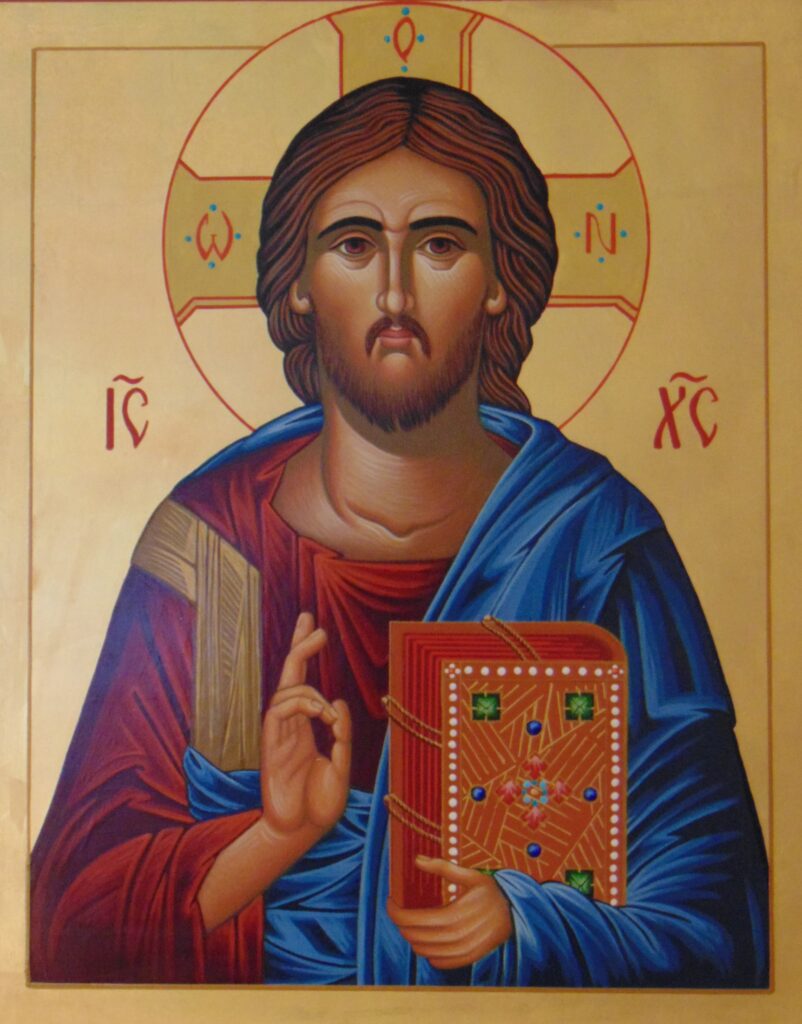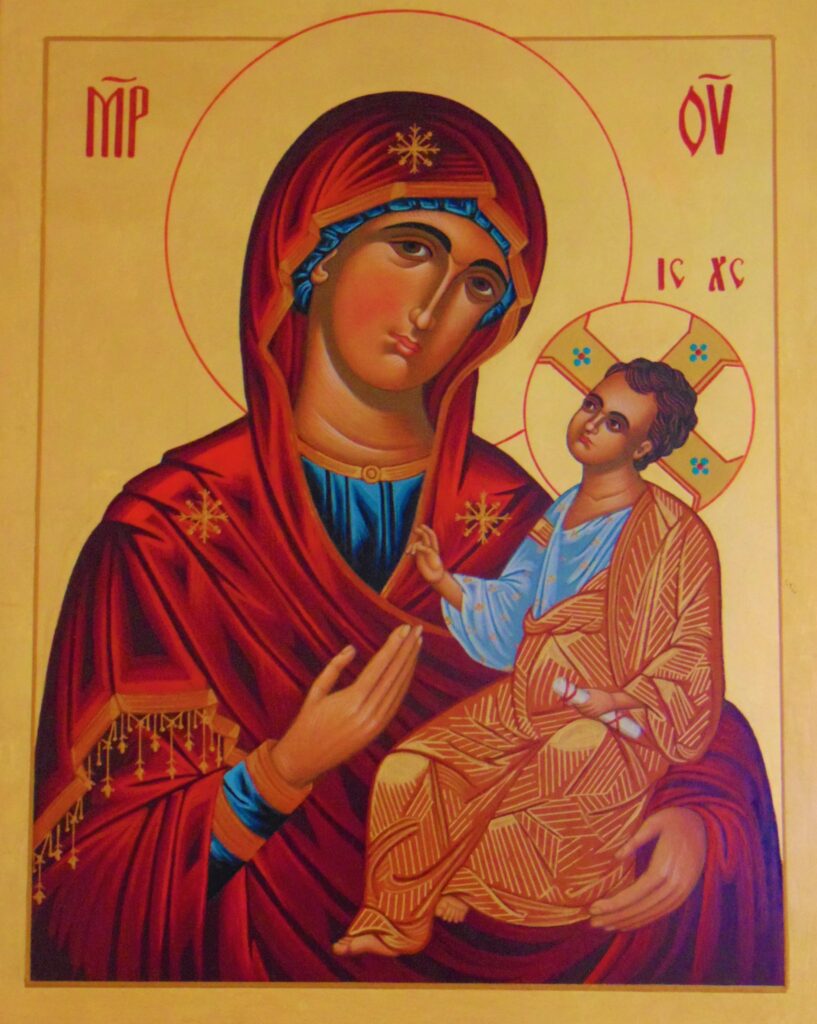

by Fr. Jonathan H. Cholcher
[This article is the third of four explaining the Orthodox Christian meaning of important topics and practices commonly misunderstood by the non-Orthodox. The four topics are: 1. Praying to Saints, 2. Prayers for the Departed, 3. The Veneration of Icons, and 4. The Sinlessness of the Virgin Mary.]
The Orthodox meaning of The Veneration of Icons was best defined at the Seventh Ecumenical Council at Nicea in the year 787. The definition reads as follows:
“[W]e keep unchanged all the ecclesiastical traditions handed down to us, whether in writing or verbally (cf. 2 Thessalonians 2:15), one of which is the making of pictorial representations, agreeable to the history of the preaching of the Gospel, a tradition useful in many respects, but especially in this, that so the incarnation (lit., enfleshment) of the Word of God (cf. John 1:14; Colossians 2:9; 1 John 4:1-3) is shown forth as real and not merely phantastic, for these have mutual indications and without doubt have also mutual significations.
“We define with all certitude and accuracy that just as the figure of the precious and life-giving Cross, so also the venerable and holy images (Gk., icons), as well in painting and mosaic as of other fit materials, should be set forth in the holy churches of God…to wit, the figure of our Lord God and Savior Jesus Christ, of our spotless Lady, the Mother of God (Gk., Theotokos; lit., Birthgiver-of-God), of the honorable Angels, of all Saints, and of all pious people.
“For by so much more frequently as they are seen in artistic representation, by so much more readily are men lifted up to the memory of their prototypes (lit., original examples), and to a longing after them; and to these should be given due salutation and honorable reverence (Gk., proskynēsis), not indeed that true worship of faith (Gk., latreia) which pertains alone to the divine nature…For the honor which is paid to the image (Gk., icon) passes on to that which the image represents, and he who reveres the image reveres in it the subject represented.”
The Orthodox are careful to distinguish between veneration and worship when making and honoring icons, which are ultimately images declaring by representation the good news of the incarnation of the Son of God for our salvation. The Veneration of Icons is a confession of the Faith that God became Man that man might become divine again, that is, “be partakers of the divine nature, having escaped the corruption that is in the world through lust” (2 Peter 1:4). “For whom [God] foreknew, He also predestined to be conformed to the image (Gk., icon) of His Son, that He might be the firstborn among many brethren” (Romans 8:29).
In the Scriptures, the term “veneration” (Gk., proskynēsis/proskynein) sometimes denotes honor, or reverence, for things other than God, and sometimes it denotes the worship of God. After Joseph swore to his father that he would not bury him in Egypt but with Abraham and Isaac in Canaan, “Israel (Jacob) bowed himself (Gk., prosekynēsen) on the top of his staff” (Genesis 47:31). “Exalt the Lord our God, and worship (Gk., proskyneite) at the footstool of His feet; for He is holy” (Psalm 98:5). “The servant therefore fell down (Gk., prosekynei) before [his king], saying, ‘Master, have patience with me, and I will pay you all’” (Matthew 18:26).
The term “worship” (Gk., latreia/latreuein) always refers to the divine service, or worship, due to God alone. “[The ungodly and unrighteous] exchanged the truth of God for the lie, and worshiped and served (Gk., elatreusan) the creature rather than the Creator, who is blessed forever. Amen” (Romans 1:25). “[T]o [the Israelites] pertain the adoption, the glory, the covenants, the giving of the law, the service of God (Gk., latreia), and the promises” (Romans 9:4).
Veneration of something or someone other than God is proper depending on the meaning of the circumstances, whereas worship is properly given to God alone. Thus the Orthodox venerate saints and icons, but the Orthodox worship God alone. Veneration of saints and icons is a vital aspect of the worship of God because God reveals His plan of salvation in the saints and icons who give glory to Him alone.
Making and veneration of icons (Gk., eikona) should never be confused with the making and worship of idols (Gk., eidōla). The commandment reads as follows: “You shall not make for yourself an idol or a likeness of anything in heaven above, or in the earth beneath, or in the waters under the earth. You shall not bow down (Gk., proskynein) to them or serve (Gk., latreuein) them” (Exodus 20:4-5; Deuteronomy 5:8-9). The veneration and worship of idols is strictly forbidden because idols are not used as images (icons) of the divine life but as divine beings in and of themselves. As Saint Paul said above, the service of idols is “worship of the creature rather than the Creator.”
Yet in the worship of God even in the Old Covenant images (icons) were commanded to be made, used, and venerated as holy. “Then you shall make two cherubim of gold; of hammered work you shall make them at the two ends of the mercy seat (i.e., the covering of the ark [storage chest] of testimony)…the cherubim shall stretch out their wings above, overshadowing the mercy seat with their wings, and they shall face one another…There I will make Myself known to you, and I will speak with you from above the mercy seat, from between the two cherubim” (Exodus 25:18-22; cherubim are a kind of angel, cf. Genesis 3:24; Ezekiel 10:1).
This ark of testimony with the covering of gold cherubim was kept in the tabernacle during Israel’s wilderness journey and occupation of the land of Canaan, and then in the Jerusalem temple when constructed by King Solomon. The ark of the testimony was carried ahead of and led the Israelites through the wilderness (see Numbers 4:5-6; 10:33; Joshua 3:3-4). The tabernacle and temple were themselves images venerated as holy, adorned with images of angels, plants, and animals (see Exodus 25-27; 3 Kingdoms 6-7).
The distinction between veneration of icons and worship of idols is clearly demonstrated with the making of the copper/bronze serpent in the wilderness. Speaking against God, God sent serpents to afflict the people of Israel. God commanded Moses to make a copper/bronze serpent and lift it up on a pole, so that whoever was bitten by a serpent, when they looked at the copper/bronze serpent would not die but live (Numbers 21:4-9). God commanded this image of the serpent to be made.
The copper serpent was kept by the Israelites. However, rather than continuing to use the copper serpent as an icon of God’s deliverance, the people misused it as an idol. “[Hezekiah, king of Judah] removed the high places and broke into pieces the sacred pillars (i.e., shrines to false gods). He cut down the sacred wooden image and broke in pieces the bronze serpent Moses had made, because up to those days, the sons of Israel had burned incense to it. They called it Nehushtan” (4 Kingdoms 18:4; Nehush is the Hebrew word meaning serpent).
Any image can become an idol through misuse, but this does not proscribe the making and venerating of images. As a matter of fact, the Lord Jesus alludes to the image of the serpent as a true icon of the divine purpose. Jesus told Nicodemus, “And as Moses lifted up the serpent in the wilderness, even so must the Son of Man be lifted up, that whoever believes in Him should not perish but have eternal life” (John 3:14-15). The image of the serpent is an icon of Christ crucified. All the images commanded by God in the Old Covenant are iconic representations leading us to the worship of Christ, e.g., the tabernacle and temple and their adornments, including the saints themselves (e.g., the high priest in his vestments, Moses, Job, Samuel, David, Elijah, Elisha, Daniel, etc.)
This brings us to the ultimate meaning of making and venerating icons, the revelation of the divine life given us in Jesus Christ the God-Man. St. Athanasios the Great writes: “For by men’s means it was impossible [to know God], since they are but made after an image (cf. Genesis 1:26); nor by angels either, for not even they are God’s images. Whence the Word of God came in His own person, that, as He was the Image (Gk., icon) of the Father (2 Corinthians 4:4; Colossians 1:15), He might be able to create afresh the man after the image…Whence He took, in natural fitness, a mortal body, that while death might in it be once for all done away, men made after His Image might once more be renewed” (On the Incarnation, 13.7, 8; italics mine).
Icons show us God become Man and all who truly share the new life in Christ. Icons communicate the divine life of the Holy Trinity given and received by the faithful in Christ. “To the [saints] God willed to make known what are the riches of the glory of this mystery among the Gentiles: which is Christ in you, the hope of glory” (Colossians 1:27). “But we all, with unveiled face, beholding as in a mirror the glory of the Lord, are being transformed into the same image (Gk., icon) from glory to glory, just as by the Spirit of the Lord…Therefore, if anyone is in Christ, he is a new creation; old things have passed away; behold, all things have become new” (2 Corinthians 3:18; 5:17).
Every child of God is an icon to be honored and venerated by the faithful for the sake of Christ. If kissing and reverencing other human beings is not, by definition, idolatry when done out of reverence for Christ in them, then making and venerating icons – pictorial and artistic representations – is not, by definition, idolatry. Rather, it is natural for human beings to have pictures and physical mementos of loved and respected persons, even to honor and kiss them. More so, then, it is natural for Christians to make and venerate icons of our Savior Jesus Christ, His mother the Theotokos, other holy people, the Cross, etc.
Moreover, the ark of the testimony was imbued with the grace and power of God (see 1 Kingdoms 5; 2 Kingdoms 6:1-7). Desecration of the holy vessels used in the tabernacle and temple was mockery of God bringing punishment (Numbers 3:10; Daniel 5:1-9), as was the mockery of holy persons (see Number 12:1-9). The prophet Elisha’s bones (relics) were grace-bearing and wonder-working (4 Kingdoms 13:21). To this day in the Orthodox Church, certain icons of saints, especially those of the Virgin Mary, exude fragrant oil (myrrh) which works miracles of healing, exorcism of demons, and comfort to the faithful. The Veneration of Icons is honor and reverence of God who in this way works salvation in the midst of the earth.
